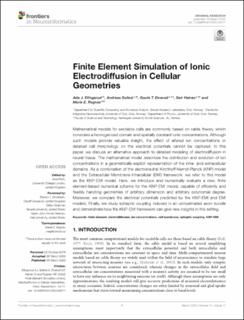| dc.contributor.author | Ellingsrud, Ada Johanne | |
| dc.contributor.author | Solbrå, Andreas Våvang | |
| dc.contributor.author | Einevoll, Gaute | |
| dc.contributor.author | Halnes, Geir | |
| dc.contributor.author | Rognes, Marie Elisabeth | |
| dc.date.accessioned | 2021-05-04T12:30:26Z | |
| dc.date.available | 2021-05-04T12:30:26Z | |
| dc.date.created | 2020-06-25T23:18:19Z | |
| dc.date.issued | 2020 | |
| dc.identifier.citation | Frontiers in Neuroinformatics. 2020, 14 1-18. | en_US |
| dc.identifier.issn | 1662-5196 | |
| dc.identifier.uri | https://hdl.handle.net/11250/2753518 | |
| dc.description.abstract | Mathematical models for excitable cells are commonly based on cable theory, which considers a homogenized domain and spatially constant ionic concentrations. Although such models provide valuable insight, the effect of altered ion concentrations or detailed cell morphology on the electrical potentials cannot be captured. In this paper, we discuss an alternative approach to detailed modeling of electrodiffusion in neural tissue. The mathematical model describes the distribution and evolution of ion concentrations in a geometrically-explicit representation of the intra- and extracellular domains. As a combination of the electroneutral Kirchhoff-Nernst-Planck (KNP) model and the Extracellular-Membrane-Intracellular (EMI) framework, we refer to this model as the KNP-EMI model. Here, we introduce and numerically evaluate a new, finite element-based numerical scheme for the KNP-EMI model, capable of efficiently and flexibly handling geometries of arbitrary dimension and arbitrary polynomial degree. Moreover, we compare the electrical potentials predicted by the KNP-EMI and EMI models. Finally, we study ephaptic coupling induced in an unmyelinated axon bundle and demonstrate how the KNP-EMI framework can give new insights in this setting. | en_US |
| dc.language.iso | eng | en_US |
| dc.rights | Navngivelse 4.0 Internasjonal | * |
| dc.rights.uri | http://creativecommons.org/licenses/by/4.0/deed.no | * |
| dc.title | Finite element simulation of ionic electrodiffusion in cellular geometries | en_US |
| dc.type | Peer reviewed | en_US |
| dc.type | Journal article | en_US |
| dc.description.version | publishedVersion | en_US |
| dc.source.pagenumber | 1-18 | en_US |
| dc.source.volume | 14 | en_US |
| dc.source.journal | Frontiers in Neuroinformatics | en_US |
| dc.identifier.doi | 10.3389/fninf.2020.00011 | |
| dc.identifier.cristin | 1817208 | |
| cristin.ispublished | true | |
| cristin.fulltext | original | |
| cristin.qualitycode | 1 | |

